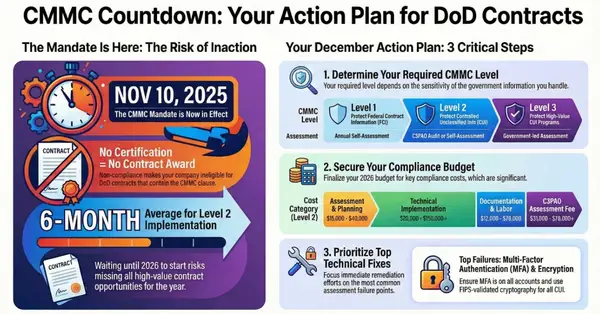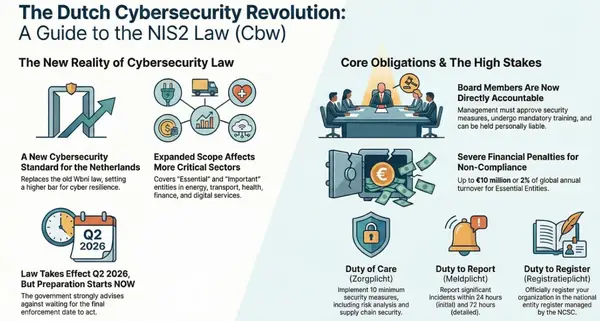EU's Cybersecurity Landscape in 2025: What Organizations Need to Know Now
The EU's cybersecurity landscape in 2025 features transformative regulations including NIS2, DORA, the Cyber Resilience Act, and AI Act enforcement. This guide outlines key compliance obligations and implementation strategies for organizations.

As cybersecurity threats continue to evolve in sophistication and impact, the European Union has responded with significant regulatory updates that took effect in early 2025. These new frameworks are reshaping how organizations approach digital security across all sectors. Here's what you need to know about the EU's latest cybersecurity compliance requirements.

The Cybersecurity Act Amendment: Expanding Certification Frameworks
On January 15, 2025, the EU adopted a targeted amendment to the Cybersecurity Act, enabling future certification schemes for 'managed security services' covering critical areas like incident response, penetration testing, security audits, and consultancy. This amendment is particularly significant as it focuses on ensuring high-quality security services that help organizations prevent, detect, and respond to security incidents.
Following this amendment, the European Commission launched a public consultation on April 11, 2025, seeking input to evaluate and potentially revise the entire Cybersecurity Act. This suggests further evolution of the regulatory landscape is imminent, emphasizing the EU's commitment to maintaining robust cybersecurity frameworks that respond to emerging threats.

The Digital Operational Resilience Act (DORA): Financial Sector Focus
January 2025 marked the launch of the EU's Digital Operational Resilience Act (DORA) regulations within the financial sector. This regulation aims to improve operational resilience in Europe's financial institutions by standardizing cybersecurity practices across the industry.
DORA's key provisions revolve around improving risk management (including for third parties) and strengthening the resilience of critical sectors to better withstand and respond to cyber threats. Financial organizations must now implement comprehensive security measures and demonstrate their ability to maintain operations during cyber incidents.
The Cyber Resilience Act: Connected Products Security
The Cyber Resilience Act, which entered into force on December 10, 2024, establishes common standards for products with digital elements, including hardware and software. This regulation is particularly relevant as more devices become connected to networks, creating potential entry points for attackers.
Under this act, products must meet specific cybersecurity requirements throughout their lifecycle, including automatic security updates and incident reporting. The Act also introduces a duty of care for manufacturers, ensuring that products are secure by design and by default.
The Cyber Solidarity Act: Collaborative Defense
The Cyber Solidarity Act entered into force on February 4, 2025, with the objective to improve the preparedness, detection, and response to cybersecurity incidents across the EU. This regulation emphasizes the importance of collaboration and information sharing to combat cyber threats effectively.

Healthcare-Specific Initiatives
On January 15, 2025, the Commission presented a European action plan on the cybersecurity of hospitals and healthcare providers, as one of the priority initiatives set out in the Political Guidelines for the 2024-2029 Commission. This sector-specific approach recognizes the unique challenges faced by healthcare institutions, which have become prime targets for cyberattacks.
The action plan proposes, among other measures, for ENISA (the EU agency for cybersecurity) to establish a pan-European Cybersecurity Support Centre for hospitals and healthcare providers, providing them with tailored guidance, tools, services, and training.
Compliance Challenges and Opportunities
For organizations operating in the EU, these new regulations present both challenges and opportunities. The compliance burden has increased, requiring dedicated resources and expertise. However, the frameworks also provide clear guidance on security best practices that can strengthen an organization's overall security posture.

Key steps organizations should take include:
- Conduct a regulatory gap assessment: Determine which regulations apply to your organization and identify areas where current security measures may fall short.
- Implement risk-based security programs: Align security investments with the specific risks faced by your organization and the requirements of relevant regulations.
- Foster a security-conscious culture: Ensure all employees understand their role in maintaining cybersecurity and compliance.
- Prepare for audits and inspections: Develop documentation and evidence collection processes that demonstrate compliance efforts.
- Monitor regulatory developments: Stay informed about changes to existing regulations and the introduction of new requirements.

Conclusion
The EU's cybersecurity regulatory landscape continues to evolve rapidly in response to emerging threats. Organizations that proactively address these new requirements will not only avoid potential penalties but also build stronger security foundations that protect their operations, reputation, and customers.
By understanding and implementing these new regulatory frameworks, organizations can turn compliance from a burden into a competitive advantage, demonstrating their commitment to security and building trust with customers and partners.
For more insights on cybersecurity frameworks and how they compare, check out our article on Comparative Analysis of Cybersecurity Frameworks, which provides valuable context on how different security standards can work together in a comprehensive security strategy.
You might also be interested in our guide to The NIST Cybersecurity Framework (CSF) 2.0, which can serve as a complementary framework to EU regulations for organizations operating globally.
Stay tuned for our upcoming webinar series where we'll dive deeper into each of these regulations and provide practical guidance for implementation.










